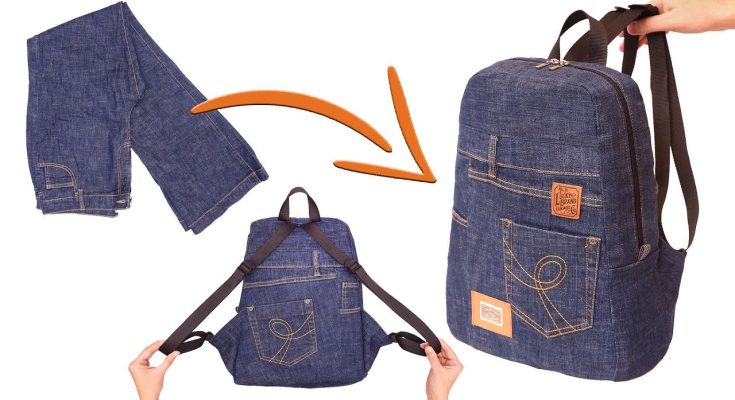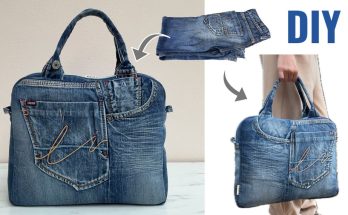You’re ready to tackle a fantastic upcycling project: turning old jeans into a practical and unique backpack! This is a super sustainable way to reuse denim, and you’ll end up with a sturdy bag with a lot of character. We’ll focus on a simple, yet durable drawstring backpack that’s easier for beginners but still looks great.
This detailed guide will walk you through each step of creating your denim backpack, from deconstructing your jeans to adding the drawstring closure and straps.
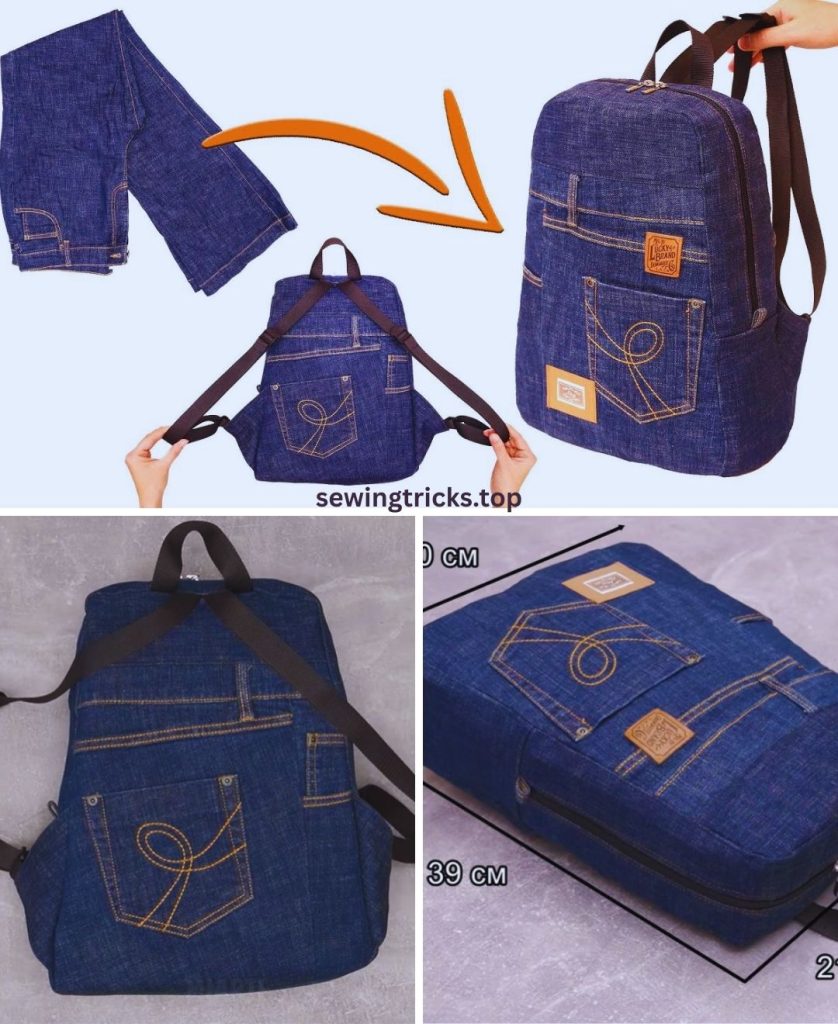
How to Sew a Simple Backpack from Old Jeans
I. Planning Your Upcycled Denim Backpack
A little planning goes a long way, especially when working with repurposed materials. It helps ensure you have enough fabric and that your project goes smoothly.
- Choose Your Jeans Wisely:
- Size: The bigger the jeans (think men’s XL or women’s larger sizes), the more usable fabric you’ll have. This makes it easier to cut larger pieces without needing to stitch together too many smaller scraps.
- Fabric Type: Non-stretch or low-stretch denim is best. High-stretch denim can be tricky to sew and might result in a less structured bag.
- Condition: Make sure the jeans are clean, free of major stains (unless you want that distressed look!), and ironed. Fading, rips, or patches can add unique character to your finished backpack.
- Desired Backpack Size: Think about what you’ll carry. This simple style is great for lighter loads like books, a change of clothes, or a tablet.
- A versatile size might be around 14 inches wide x 16 inches tall when finished.
- Key Denim Features to Reuse:
- Back Pockets: These are perfect for the front of your backpack! They add instant utility and that classic jean look.
- Waistband: You can often use a piece of the waistband for a sturdy top hanging loop.
- Original Seams: The thick, topstitched seams from the legs can be incorporated into your design for visual interest.
- Lining (Optional but Recommended): While this is a “simple” method, adding a lining significantly increases durability and gives your backpack a much more finished, professional look inside. We’ll include instructions for a basic lining.
- Closure: A drawstring closure is the simplest and most common for this style of backpack.
II. Gather Your Materials
Having all your supplies ready before you begin will make the sewing process much smoother and more enjoyable.
- Old Jeans: 1 large pair of clean, ironed, sturdy denim jeans.
- Lining Fabric (Optional): 1 yard (0.9 meters) of medium-weight quilting cotton, broadcloth, or poly-cotton. Choose a fabric that complements your denim.
- Drawstring Cord: 2.5 to 3 yards (2.3 to 2.7 meters) of sturdy cord (e.g., paracord, cotton rope, thick shoelaces, or even braided fabric strips from your jeans). Choose a thickness that will fit through your buttonholes or grommets.
- Matching Thread: Strong, all-purpose polyester thread. For topstitching on denim, use a slightly thicker topstitching thread in a contrasting color (like gold, orange, or beige) for that authentic jean look.
- Heavy-Duty Needles: Denim needles (size 90/14 or 100/16) are essential for piercing thick denim. Keep spares on hand, as they can break.
- Basic Sewing Supplies:
- Sewing Machine: It needs to handle thick layers. A walking foot is highly recommended as it helps feed thick fabric layers evenly.
- Sharp Fabric Scissors or Rotary Cutter and Mat.
- Long Quilting Ruler or Measuring Tape.
- Fabric Chalk or Mark-B-Gone Pen.
- Plenty of Wonder Clips (superior to pins for holding thick denim layers).
- Iron and Ironing Board (crucial for pressing seams flat).
- Seam Ripper (your best friend for deconstructing jeans!).
- Safety Pin or Bodkin: For threading the drawstring.
- Optional: Buttonhole foot for your machine (if making buttonholes) or grommet setting tool and grommets (if using grommets for cord holes).
III. Prepare Your Jeans & Cut Fabric Pieces
This is often the most time-consuming part, but taking your time here ensures a great final product.
A. Deconstruct Your Jeans:
- Cut Off Legs: Lay the jeans flat and smooth. Using your sharp fabric scissors, cut straight across both pant legs, just below the crotch seam.
- Open Leg Seams: Use your seam ripper to carefully open up both the inseam (inner leg seam) and the outseam (outer leg seam) of each cut-off leg. This will give you two large, flat panels of denim fabric. Iron these pieces flat to remove any creases.
- Harvest Back Pockets (Optional): If you plan to use the original back pockets on your backpack, carefully seam rip them off the jeans.
- Save Waistband (Optional): If you want to use a piece of the waistband for a top hanging loop, cut off a section about 5-6 inches (12.7-15 cm) long, including a belt loop if desired.
B. Determine Your Panel Sizes (Example: 14″ W x 16″ H Backpack):
We’ll use a consistent 1/2-inch (1.27 cm) seam allowance throughout this project.
- Main Body Panel Width: Finished Width + (2 * Seam Allowance) = 14″ + 1″ = 15 inches (38 cm)
- Main Body Panel Height: Finished Height + (2 * Seam Allowance for bottom + 2.5″ for drawstring casing) = 16″ + 0.5″ + 2.5″ = 19 inches (48.3 cm)
- Note: We’re adding extra height for the drawstring casing.
C. Cut Your Fabric Pieces:
- Exterior Denim Pieces (from your jeans):
- Main Body (Front & Back): Cut 2 rectangles, each 15 inches wide x 19 inches high.
- Important on Piecing: It’s very likely you’ll need to piece together sections of your opened-up jean legs to achieve these large panel dimensions.
- How to Piece Denim:
- Lay out your opened jean pieces. Arrange them to maximize your cuts.
- Place two denim pieces right sides together, aligning a long raw edge.
- Stitch them together using a 1/2-inch (1.27 cm) seam allowance.
- Press the seam open thoroughly to reduce bulk.
- Topstitch (Highly Recommended!): On the right side of the fabric, sew two parallel lines of stitching, one on each side of the seam line, about 1/8 inch (0.3 cm) away. Use your topstitching thread for this. This mimics authentic jean seams and adds immense strength.
- Continue piecing until you have two panels large enough.
- Loop Connectors (for drawstring/straps): Cut 2 rectangles, each 3 inches wide x 3 inches high.
- Top Hanging Loop (Optional, from waistband or denim scrap): 1 strip, about 2 inches wide x 5-6 inches long.
- Main Body (Front & Back): Cut 2 rectangles, each 15 inches wide x 19 inches high.
- Lining Fabric Pieces (Optional):
- Main Body (Front & Back): Cut 2 rectangles, each 15 inches wide x 19 inches high.
- Interior Slip Pocket (Optional): Cut 1 rectangle, 8 inches wide x 10 inches high.
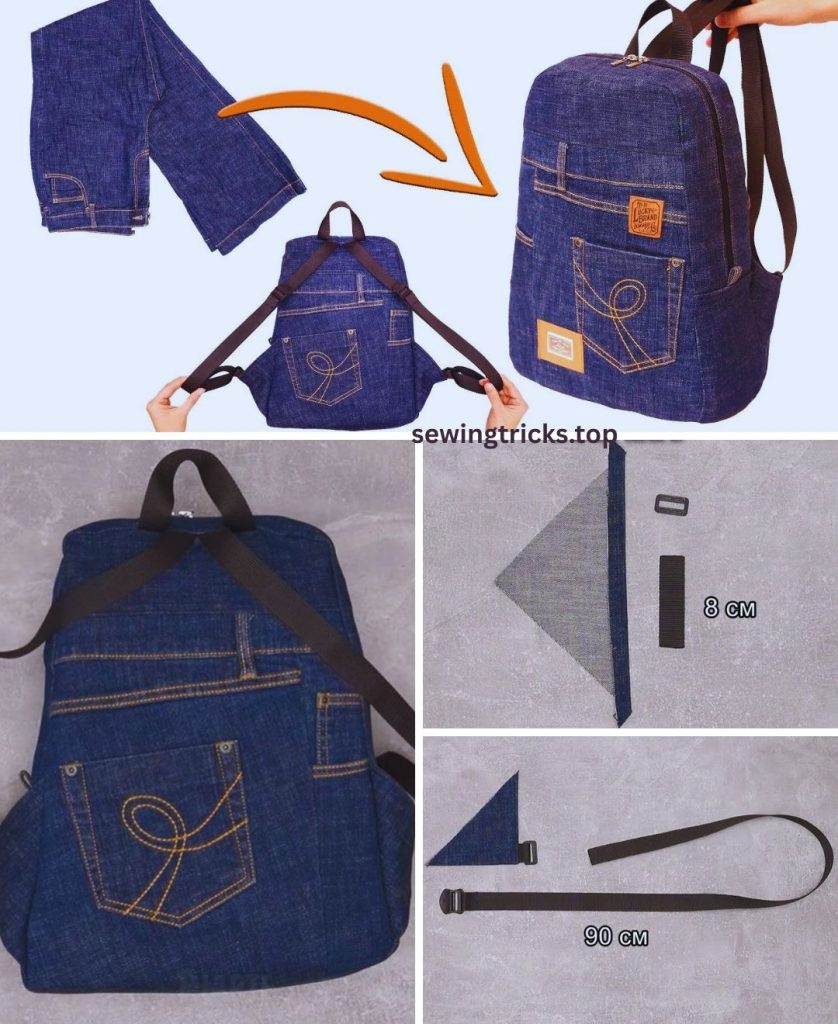
IV. Let’s Start Sewing Your Simple Denim Backpack!
General Sewing Tips for Denim:
- Always use a fresh, sharp denim needle. Essential for smooth sewing.
- Use your walking foot. This is really helpful for feeding thick layers evenly.
- Go Slow! Stitch slowly, especially over any existing jean seams or pieced areas. Gently hand-crank your machine over very thick spots.
- Wonder Clips are your best friends! They hold thick denim layers much better than pins.
- Press, Press, Press. Pressing seams open after each step reduces bulk and creates crisp, professional results. Use a good, hot iron.
- Topstitching: Use a slightly longer stitch length (3.0-3.5mm) for all topstitching to get that characteristic denim look.
Step 1: Prepare Exterior Denim Panels & Add Pockets
- Add Exterior Pockets (Optional): If using salvaged back pockets, position one onto one Exterior Denim Main Body Panel (this will be the front of your backpack). Topstitch the pocket in place along its two sides and bottom edge. Reinforce the top corners with an X-box stitch.
Step 2: Attach Bottom Loop Connectors
These loops are where your drawstring will exit and create the backpack straps.
- Take your two Loop Connector pieces (3″ x 3″ denim).
- Fold each piece in half lengthwise, wrong sides together, and press. Then, fold each long raw edge into the center crease and press again. Finally, fold in half along the original center crease. You’ll have a strip about 3/4 inch wide with no raw edges.
- Topstitch down both long sides of each prepared loop, about 1/8 inch (0.3 cm) from the edge.
- On the Exterior Denim Front Body Panel, measure up about 1 inch (2.5 cm) from the bottom raw edge, and in from each side raw edge by about 1.5 inches (3.8 cm). Mark these points.
- Take one prepared loop connector. Fold it in half to create a loop. Position the raw ends of this loop at one of your marked points, with the loop facing upward (into the bag). The raw ends should align with the bottom raw edge of the backpack panel.
- Stitch the loop in place within the 1/2-inch (1.27 cm) seam allowance, using a sturdy X-box stitch for reinforcement. Repeat for the other loop on the other side of the front panel.
Step 3: Construct the Exterior Denim Bag Body
Use a 1/2-inch (1.27 cm) seam allowance.
- Place the two Exterior Denim Main Body Panels right sides together, carefully aligning all raw edges. Ensure your loops on the front panel are tucked safely inside so they don’t get caught in the side seams.
- Clip securely along both side edges and the entire bottom edge. The top edge remains open.
- Stitch from one top corner down that side, pivot sharply at the bottom corner, stitch straight across the bottom, pivot again, and stitch up the other side to the top corner. Backstitch at the beginning and end of your seam.
- Press your seams open thoroughly to reduce bulk.
Step 4: Prepare the Drawstring Casing
This creates the channel for your drawstring at the top of the backpack.
- With the exterior denim bag still wrong side out, fold the top raw edge down towards the wrong side by 1/2 inch (1.27 cm) and press firmly.
- Fold it down again by 2 inches (5 cm) and press firmly. This creates your casing. The raw edge should be tucked inside this double fold.
- Pin or clip this casing generously all around the top opening.
- Stitch the casing in place by sewing a line of stitching close to the inner folded edge of the casing (about 1/8 inch / 0.3 cm from the fold). This creates the bottom of your casing channel.
- Optional Top Stitch: You can also sew a second line of stitching 1/8 inch (0.3 cm) from the very top folded edge of the casing. This creates a neat finish and reinforces the top.
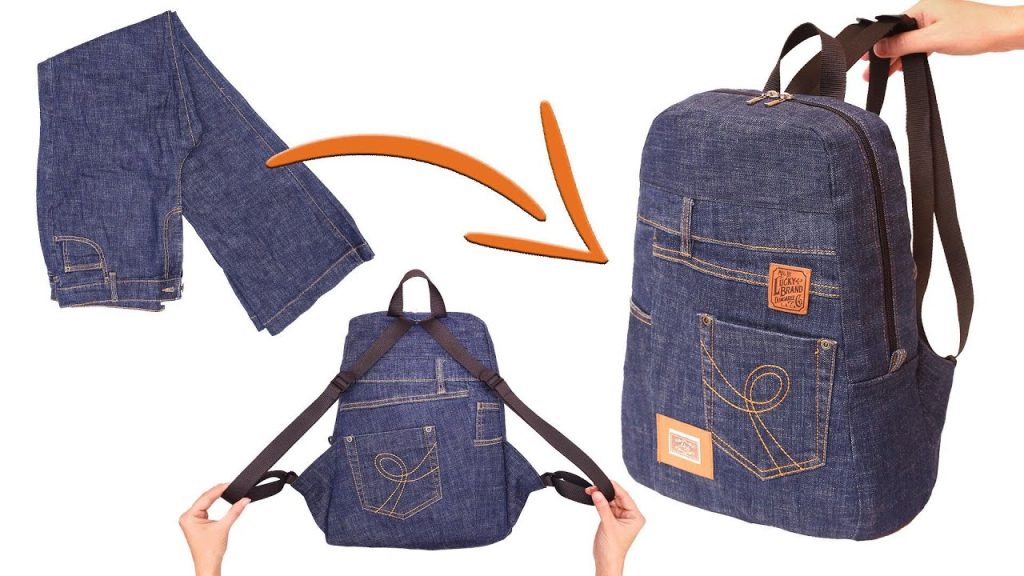
Step 5: (Optional) Sew the Lining Bag Body
If you’re adding a lining, follow these steps. If not, skip to Step 6.
- Prepare Interior Slip Pocket (Optional):
- Take your 8″ x 10″ pocket piece. Fold it in half, right sides together, so it’s 8″ x 5″. Stitch around three sides, leaving a 3-4 inch (7.6-10.2 cm) opening on the remaining short side (bottom of pocket). Trim corners.
- Turn pocket right side out through the opening. Press flat. Stitch the opening closed by machine (very close to the edge) or by hand (invisible ladder stitch).
- Attach Pocket: Take one Lining Fabric Main Body Panel. Position pocket about 4-5 inches (10-12.7 cm) down from the top, centered. Topstitch along its two sides and bottom edge. Reinforce top corners.
- Construct Lining Body:
- Place the two Lining Fabric Main Body Panels right sides together.
- Stitch along both side seams and the bottom seam using a 1/2-inch (1.27 cm) seam allowance.
- CRUCIAL STEP: For the bottom seam, leave an opening! Stitch approximately 3 inches (7.6 cm) from one side, then leave a 4-6 inch (10-15 cm) unstitched gap in the middle of the bottom seam. Stitch the remaining 3 inches. Backstitch well. This opening is essential for turning the backpack right side out later.
- Press your seams open.
- Result: Your lining bag is now formed, with an open top and a turning gap in the bottom. Keep it wrong side out.
Step 6: Join Exterior Bag and Lining (if using lining) or Finish Exterior Top
A. If Using Lining:
- Ensure your exterior denim bag is right side out.
- Ensure your lining bag is wrong side out.
- Carefully insert the exterior denim baginto the lining bag.
- The wrong side of the exterior bag’s casing should be facing the right side of the lining.
- Align the top raw edge of the lining with the top raw edge of the exterior bag’s casing (just below the casing seam). Align side seams.
- Clip all the way around the top opening.
- Stitch the lining to the exterior bag along this top edge, using a 1/2-inch (1.27 cm) seam allowance. Backstitch. This seam will be hidden by the casing.
B. If NOT Using Lining:
You already formed your casing in Step 4. You’re ready for Step 7.
Step 7: Create Drawstring Holes
You need openings on either side of your casing to thread the drawstring.
- On the exterior denim bag, find the exact center of the front panel. Mark two points about 1 inch (2.5 cm) in from each side seam, within the casing area (between the two lines of stitching you made in Step 4).
- Option 1: Buttonholes (Recommended for neatness): Use your sewing machine’s buttonhole foot to sew two vertical buttonholes at your marked points. Carefully cut them open with a seam ripper.
- Option 2: Grommets: Mark two points about 1 inch (2.5 cm) in from each side seam. Following the manufacturer’s instructions, use your grommet setting tool to install grommets at these points.
- Note: If you’re not using a lining, these holes are directly on the exterior. If you have a lining, these holes will go through both layers.
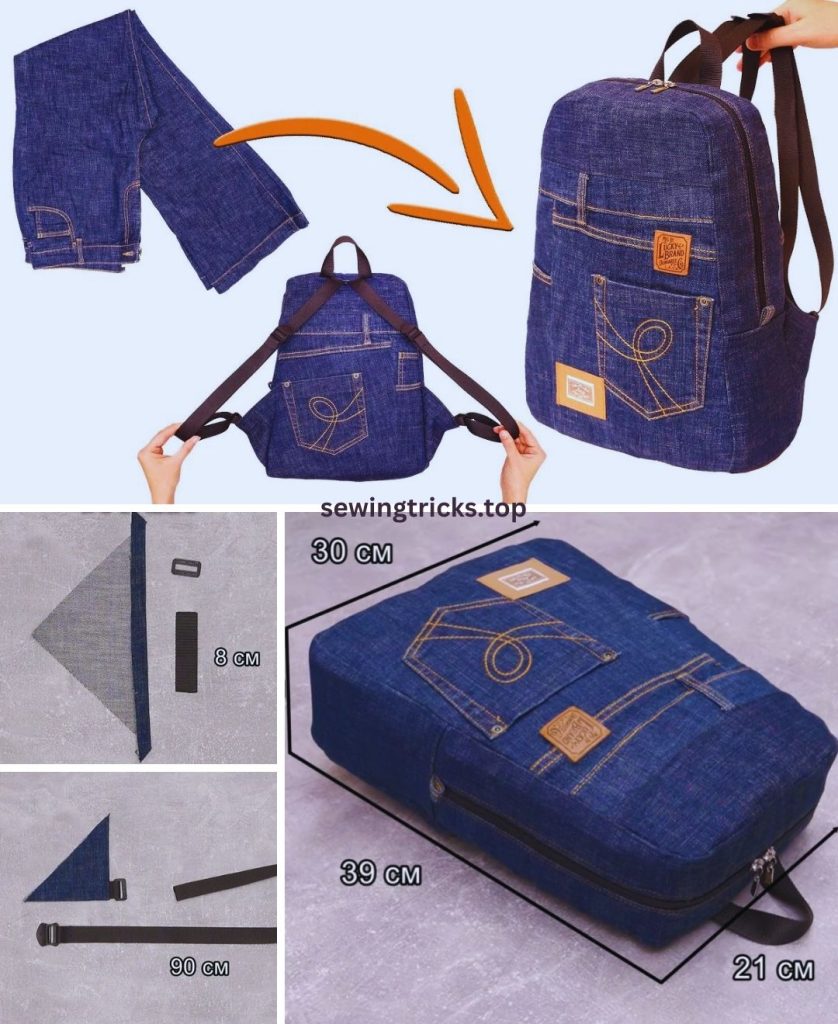
Step 8: Thread the Drawstring
This is where your backpack really starts to take shape!
- Cut your drawstring cord into two equal pieces.
- Take the first piece of cord. Attach a large safety pin or a bodkin to one end.
- Start at one of the drawstring holes you just made (e.g., the front-right hole). Thread the cord all the way through the casing, around the back, and back out the same hole you started in (the front-right hole).
- Take the second piece of cord. Thread it through the other drawstring hole (the front-left hole), all the way around, and back out the same hole.
- Now you have two cord ends coming out of each hole.
Step 9: Attach Drawstring Ends to Bottom Loops
- Take the two ends of the cord coming out of the front-right hole.
- Feed them down the right side of the backpack exterior to the bottom right loop connector you sewed in Step 2.
- Thread both cord ends through this bottom loop.
- Tie the two cord ends together in a secure knot (a double knot or fisherman’s knot works well). Trim any excess cord.
- Repeat this process for the two cord ends coming out of the front-left hole, feeding them down the left side of the backpack exterior and tying them securely through the bottom left loop connector.
Step 10: Final Touches (Turn and Close Lining)
- If you have a lining, reach through the opening you left in the bottom seam of the lining (Step 5).
- Slowly and carefully pull the entire backpack through this opening until it is completely right side out. Take your time, gently pushing out all the corners for a crisp shape.
- Close the Lining Opening: Press the raw edges of the opening in the bottom of the lining under by 1/2 inch (1.27 cm) so they meet neatly. Align these pressed edges and clip them together. Stitch this opening closed by machine (sewing very close to the folded edge for a neat finish) or by hand using an invisible ladder stitch for a truly seamless look.
- Push the lining down into the exterior denim backpack.
- Optional Top Hanging Loop: If you prepared a waistband piece or denim strip for a top loop, fold it in half to create a loop. Hand-stitch or machine-stitch it securely to the back of the backpack, just below the drawstring casing, in the center.
Your unique, upcycled denim backpack is now complete! You’ve transformed old jeans into a functional, durable, and stylish accessory. To use it, pull the two loops of cord to cinch the top closed, and the loops at the bottom will form your shoulder straps. Enjoy carrying your sustainable creation with pride!
What other simple sewing projects are you considering?

